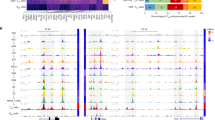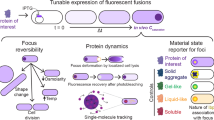Abstract
In gradients of external chemo-attractant, mammalian neutrophilic leukocytes (neutrophils)1 and Dictyostelium discoideum amoebae2 adopt a polarized morphology and selectively accumulate lipid products of phosphatidylinositol-3-OH kinases (PI(3)Ks), including PtdIns(3,4,5)P3, at their up-gradient edges; the internal PtdIns(3,4,5)P3 gradient substantially exceeds that of the external attractant. An accompanying report3 presents evidence for a positive feedback loop that amplifies the gradient of internal signal: PtdIns(3,4,5)P3 at the leading edge stimulates its own accumulation by inducing activation of one or more Rho GTPases (Rac, Cdc42, and/or Rho), which in turn increase PtdIns(3,4,5)P3 accumulation. Here we show that interruption of this feedback by treatment with PI(3)K inhibitors reduces the size and stability of pseudopods and causes cells to migrate in jerky trajectories that deviate more from the up-gradient direction than do those of controls. Moreover, amplification of the internal PtdIns(3,4,5)P3 gradient is markedly impaired by latrunculin or jasplakinolide, toxins that inhibit polymerization4,5 or depolymerization6 of actin, respectively. Thus reciprocal interplay between PtdIns(3,4,5)P3 and polymerized actin initiates and maintains the asymmetry of intracellular signals responsible for cell polarity and directed motility.
This is a preview of subscription content, access via your institution
Access options
Subscribe to this journal
Receive 12 print issues and online access
$209.00 per year
only $17.42 per issue
Buy this article
- Purchase on Springer Link
- Instant access to full article PDF
Prices may be subject to local taxes which are calculated during checkout




Similar content being viewed by others
References
Servant, G. et al. Science 287, 1037–1040 (2000).
Meili, R. et al. EMBO J. 18, 2092–2105 (1999).
Weiner, O. D. et al. Nature Cell Biol. DOI: 10.1038/ncb811.
Coue, M., Brenner, S. L., Spector, I. & Korn, E. D. FEBS Lett. 213, 316–318 (1987).
Spector, I., Shochet, N. R., Kashman, Y. & Groweiss, A. Science 219, 493–495 (1983).
Bubb, M. R., Senderowicz, A. M., Sausville, E. A., Duncan, K. L. & Korn, E. D. J. Biol. Chem. 269, 14869–14871 (1994).
Rickert, P., Weiner, O. D., Wang, F., Bourne, H. R. & Servant, G. Trends Cell Biol. 10, 466–473 (2000).
Chung, C. Y., Funamoto, S. & Firtel, R. A. Trends Biochem. Sci. 26, 557–566 (2001).
Haugh, J. M., Codazzi, F., Teruel, M. & Meyer, T. J. Cell Biol. 151, 1269–1280 (2000).
Funamoto, S., Milan, K., Meili, R. & Firtel, R. A. J. Cell Biol. 153, 795–810 (2001).
Knall, C., Worthen, G. S. & Johnson, G. L. Proc. Natl Acad. Sci. USA 94, 3052–3057 (1997).
Hirsch, E., et al. Science 287, 1049–1053 (2000).
Niggli, V. & Keller, H. Eur. J. Pharmacol. 335, 43–52 (1997).
Li, Z., et al. Science 287, 1046–1049 (2000).
Sasaki, T., et al. Science 287, 1040–1046 (2000).
Niggli, V. FEBS Lett. 473, 217–221 (2000).
Foxman, E. F., Campbell, J. J. & Butcher, E. C. J. Cell Biol. 139, 1349–1360 (1997).
Sheikh, S., Gratzer, W. B., Pinder, J. C. & Nash, G. B. Biochem. Biophys. Res. Commun. 238, 910–915 (1997).
Stephens, L. R. et al. Cell 89, 105–114 (1997).
Naccache, P. H. et al. J. Biol. Chem. 275, 23636–23641 (2000).
Hannigan, M. et al. Proc. Natl Acad. Sci. USA 99, 3603–3608 (2002).
Ayscough, K. R. Curr. Biol. 10, 1587–1590 (2000).
Ayscough, K. R. & Drubin, D. G. Curr. Biol. 8, 927–930 (1998).
Peyrollier, K. et al. Biochem. J. 352, 617–622 (2000).
Servant, G., Weiner, O. D., Neptune, E. R., Sedat, J. W. & Bourne, H. R. Mol. Biol. Cell. 10, 1163–1178 (1999).
Weiner, O. D. et al. Nature Cell Biol. 1, 75–81 (1999).
Acknowledgements
We thank members of the Bourne laboratory for valuable discussions. This work was supported by National Institutes of Health grants GM-27800 and CA-54427 to H.R.B., an NIH training grant HL07713 to F.W., and a grant from the Leukemia and Lymphoma Society to S.S.
Author information
Authors and Affiliations
Corresponding author
Ethics declarations
Competing interests
The authors declare no competing financial interests.
Supplementary information
Rights and permissions
About this article
Cite this article
Wang, F., Herzmark, P., Weiner, O. et al. Lipid products of PI(3)Ks maintain persistent cell polarity and directed motility in neutrophils. Nat Cell Biol 4, 513–518 (2002). https://doi.org/10.1038/ncb810
Received:
Revised:
Accepted:
Published:
Issue Date:
DOI: https://doi.org/10.1038/ncb810
This article is cited by
-
An Intriguing Structural Modification in Neutrophil Migration Across Blood Vessels to Inflammatory Sites: Progress in the Core Mechanisms
Cell Biochemistry and Biophysics (2024)
-
Directional reorientation of migrating neutrophils is limited by suppression of receptor input signaling at the cell rear through myosin II activity
Nature Communications (2021)
-
Mutation-specific non-canonical pathway of PTEN as a distinct therapeutic target for glioblastoma
Cell Death & Disease (2021)
-
The polarity protein PARD3 and cancer
Oncogene (2021)
-
Mechanochemical modeling of neutrophil migration based on four signaling layers, integrin dynamics, and substrate stiffness
Biomechanics and Modeling in Mechanobiology (2018)



